AUD/USD and NZD/USD Fundamental Daily Forecast – Aussie May Be Getting Ready Rollover to Downside
The Australian and New Zealand Dollars traded mixed on Thursday with the Aussie trading lower and the Kiwi posting a modest gain. Both Forex pairs posted volatile two-sided trades on Wednesday in response to the Fed’s interest rate decision and monetary policy statement. However, the buying wasn’t strong enough to take out last week’s highs. This suggests that a top may finally be in.
The AUD/USD settled at .8056, down 0.0028 or -0.35% and the NZD/USD finished at .7365, down 0.0034 or 0.46%.

The moves make sense because earlier in the week, Australia released a report on quarterly consumer inflation that came in slightly lower-than-expected, dashing all hope for a sooner-than-expected rate hike by the Reserve Bank of Australia. The New Zealand Dollar, on the other hand, was supported by the release of trade data on January 30 which showed a surprisingly high trade surplus which was the highest surplus on record for December.
This news was followed by a positive assessment of the New Zealand economy’s credit rating by rating agency Standard & Poor, which appeared to endorse a rosier outlook for the economy which is expected to rub off on the currency.
In other news, the U.S. Federal Reserve ended its two-day meeting by announcing it would not raise its benchmark interest rate. However, it indicated that it expects inflation pressures to heat up as the year moves on.
The decision by the Federal Open Market Committee to leave interest rates at 1.25 to 1.50 percent was widely expected. This decision had almost no impact on the markets. However, investors were looking at the statement for clues on how the central bank might proceed for the rest of the year. This was going to be the news that moved the markets.
According to projections released in December, FOMC officials expect three rate hikes this year so long as there is no significant disruption to market conditions. Recent price action in the Treasury markets, however, suggests that investors may believe the Fed is considering a fourth rate hike.
Today’s Fed statement contains a few tweaks which could influence the market’s view on the timing and the number of future rate hikes.

Forecast
Earlier in the session, in Australia, the AIG Manufacturing Index came in at 58.7. Building Approvals fell 20.0%. Traders were looking for a 7.9% decline. Quarterly Import Prices rose 2.0% versus a 1.5% estimate. Commodity Prices fell 0.6% on an annualized basis.
On Thursday, investors will get the opportunity to react to a slew of U.S. economic report. Minor reports include Challenger Job Cuts, Preliminary Nonfarm Productivity, Preliminary Unit Labor Costs, Weekly Unemployment Claims, Final Manufacturing PMI, Construction Spending and ISM Manufacturing Prices.
The major report on Thursday is the ISM Manufacturing PMI. It is expected to come in at 58.7, slightly below the previous 59.7.
With the economy starting to heat up, Treasury yields should continue to rise, helping to underpin the dollar. Additionally, the possibility of more than three rate hikes by the Fed this year is also bullish for the dollar. So why isn’t the dollar rallying against the Aussie and Kiwi? Traders may be waiting for Friday’s U.S. Non-Farm Payrolls report before making their move.
This article was originally posted on FX Empire

 Yahoo Finance
Yahoo Finance 